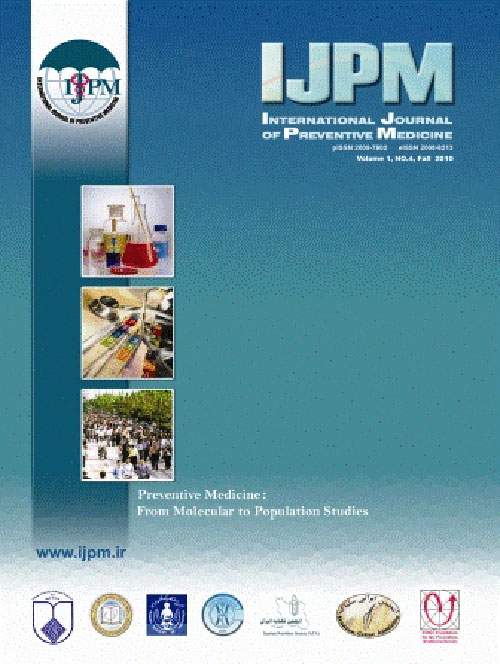فهرست مطالب

International Journal of Preventive Medicine
Volume:8 Issue: 10, Oct 2017
- تاریخ انتشار: 1396/08/03
- تعداد عناوین: 8
-
-
Page 1Children with cancer treated with cytotoxic drugs are frequently at risk of developing renal dysfunction. The cytotoxic drugs that are widely used for cancer treatment in children are cisplatin (CPL), ifosfamide (IFO), carboplatin, and methotrexate (MTX). Mechanisms of anticancer drug‑induced renal disorders are different and include acute kidney injury (AKI), tubulointerstitial disease, vascular damage, hemolytic uremic syndrome (HUS), and intrarenal obstruction.
CPL nephrotoxicity is dose‑related and is often demonstrated with hypomagnesemia, hypokalemia, and impaired renal function with rising serum creatinine and blood urea nitrogen levels. CPL, mitomycin C, and gemcitabine treatment cause vascular injury and HUS. High‑dose IFO, streptozocin, and azacitidine cause renal tubular dysfunction manifested by Fanconi syndrome, rickets, and osteomalacia. AKI is a common adverse effect of MTX, interferon‑alpha, and nitrosourea compound treatment. These strategies to reduce the cytotoxic drug‑induced nephrotoxicity should include adequate hydration, forced diuresis, and urinary alkalization. Amifostine, sodium thiosulfate, and diethyldithiocarbamate provide protection against CPL‑induced renal toxicity.Keywords: Acute kidney injury, anti‑cancer drugs, chemotherapy, children, glomerular fltration rate, nephrotoxicity -
Page 2BackgroundDrugs targeting Angiotensin I‑converting enzyme (ACE) have been used broadly in cancer chemotherapy. The recent past coupled with our results demonstrates the effective use of ACE inhibitors (ACEi) as anticancer agents, and they are potentially relevant in deriving new inhibitors.MethodsBacterial strains were isolated from cow milk collected in Coimbatore, Tamil Nadu, India and plated on nutrient agar medium. The identity of the strain was ascertained by 16s rRNA gene sequencing method and was submitted to the NCBI GenBank nucleotide database. Various substrates were screened for ACEi production by the fermentation with the isolated strain. ACEi was purifed by sequential steps of ethanol precipitation, ion exchange column chromatography and gel fltration column chromatography. The apparent molecular mass was determined by SDSPAGE. The anticancer property was analyzed by studying the cytotoxicity effects of ACEi using Breast cancer MCF‑7 cell lines.ResultsThe isolate coded as BUCTL09 was selected and identifed as Micrococcus luteus. Among the seven substrates, only beef extract fermented broth showed an inhibition of 79% and was reported as the best substrate. The peptide was purifed and molecular mass was determined. The IC50 value of peptide was found to be 59.5 µg/ ml. The purifed peptide has demonstrated to induce apoptosis of cancer cell.ConclusionsThe results of this study revealed that Peptide has been determined as an active compound that inhibited the activity of ACE. These properties indicate the possibilities of the use of purifed protein as a potent anticancer agent.Keywords: 16S rRNA gene sequence, angiotensin‑converting enzyme inhibitor, anticancer activity, antimetastatic, antiproliferative, beef extract, hippuric acid, MCF‑7 cell line, Micrococcus luteus
-
Page 3IntroductionPolycystic ovary syndrome (PCOS) is the most common endocrinopathy in women in reproductive age that is associated with insulin resistance (IR) and metabolic abnormalities which are also a part of metabolic syndrome (Met S). This study was aimed to determine the prevalence of nonalcoholic fatty liver disease (NAFLD) women diagnosed with PCOS based on the Rotterdam criteria from January 2013 to June 2014.MethodsIn this cross‑sectional study, 75 women with PCOS and 75 healthy controls were enrolled. Anthropometric parameters, biochemical and hormonal investigation, were measured in all women. IR was calculated by homeostasis model assessment. Abdominal ultrasonography and biochemical tests were used to determine the NAFLD.ResultsThe level of triglyceride, cholesterol, low‑density lipoprotein, aspartate aminotransferase, alkalin phosphatase, fasting insulin, and homeostatic model assessment index in women with PCOS were signifcantly higher than women without PCOS. High‑density lipoprotein and alanine aminotransferase (ALT) in women with PCOS were signifcantly lower. The frequency of IR women with or without PCOS was 53.3% and 29.3%, respectively (P = 0.003). The frequency of Met S in women with PCOS was 33.3% and in other was 10.7% (P = 0.001). The prevalence of fatty liver in women with or without PCOS was 38.7% and 18.7%, respectively (0.008). In women with PCOS, body mass index (BMI) (odds ratio [OR] = 4.25; P = 0.046), ALT (OR = 1.62; P = 0.005), fasting insulin (OR = 1.32; P = 0.032), and IR (OR = 58.17; P = 0.025) were associated with a higher fatty liver.ConclusionsNAFLD is frequent in patients with PCOS with combination with other metabolic derangements. BMI, ALT, fasting insulin, and IR are the risk factors for high prevalence of NAFLD in women with PCOS.Keywords: Fatty liver, metabolic syndrome, polycystic ovary syndrome
-
Page 4BackgroundDihydroartemisinin (DHA) is a semisynthetic derivative of artemisinin and has antiproliferative effect. However, such effects of DHA have not yet been revealed for bladder cancer cells.MethodsWe used as bladder cancer cell lines to examine the effect of DHA on the cell viability, cell apoptosis, and monitoring of mitochondrial membrane potential (ΔΨm) changes. Furthermore, the effect of DHA on the reactive oxygen species (ROS) production and cytochrome c release were also detected. We employed MTT assay to investigate the cell proliferation effect of DHA on the EJ‑138 and HTB‑9 human bladder cancer cells. Annexin/PI staining, caspase‑3 activity assay, Bcl‑2/Bax protein expression, mitochondrial membrane potential assay, cytochrome c release, and ROS analysis were used for apoptosis detection.ResultsDHA signifcantly reduced cell viability in a dose‑dependent manner. Cytotoxicity of DHA was suppressed by N‑acetylcysteine. The growth inhibition effect of DHA was related to the induction of cell apoptosis, which were manifested by annexin V‑FITC staining, activation of caspase‑3. DHA also increased ROS generation, cytochrome c release, and loss of mitochondrial transmembrane potential (ΔΨm) in cells. In addition, the downregulation of regulatory protein Bcl‑2 and upregulation of Bax protein by DHA were also observed.ConclusionsThese fndings demonstrated that DHA induces apoptosis through mitochondrial signaling pathway. These suggest that DHA may be a potential agent for induction of apoptosis in human bladder cancer cells.Keywords: Apoptosis, artemisinins, reactive oxygen species, urinary bladder neoplasms
-
Page 7

